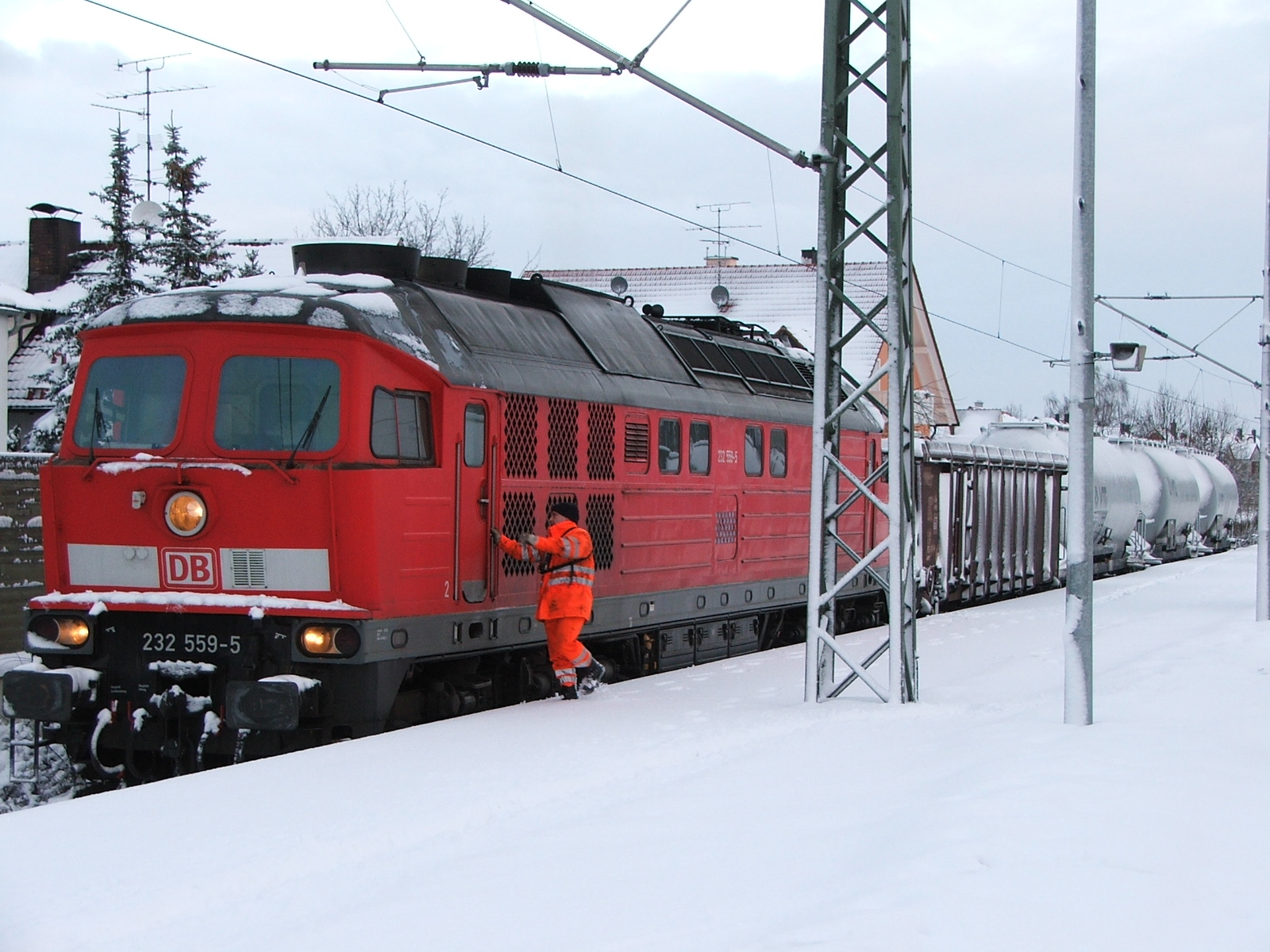- DR Class 132
Infobox Locomotive
name = DR Class 132
powertype =Diesel 
caption = DB 232 559 in the snow, 1 Feb, 2005.
builder =October Revolution Locomotive Works
serialnumber =
buildmodel =
builddate =1973 -1982
totalproduction = over 1000
whytetype =
aarwheels =Co-Co
uicclass =
gauge = 1435 mm
leadingsize =
driversize = 1050 mm
trailingsize =
wheelbase =
length = 20.62 m
width =
height =
framesize =
weightondrivers = 10.2 t
weight = 123 t
locotenderweight =
fueltype =Diesel
fuelc
tenderc
consumption =
watercons =
electricsystem =
collectionmethod =
primemover =
enginetype =
aspiration =
displacement =
boiler =
boilerpressure =
feedwaterheater =
firearea =
tubearea =
fluearea =
tubesandflues =
fireboxarea =
totalsurface =
superheatertype =
superheaterarea =
cylindercount =
cylindersize =
rearcylindersize =
hpcylindersize =
lpcylindersize =
valvegear =
transmission =
topspeed =
poweroutput = 2200 kW
tractiveeffort =
factorofadhesion =
locobrakes =
trainbrakes =
railroad =DB
railroadclass = 232
numinclass = 600
roadnumber = 232 002-232 708 (with gaps)
officialname =
nicknames = Ludmilla
locale =
deliverydate =1973 -1982 to DR
firstrundate =
lastrundate =
retiredate =
restoredate =
scrapdate =
currentowner =
disposition =|DR Class 132/DBAG Class 232
The diesel locomotive class 232 was introduced 1973 into
Deutsche Reichsbahn (GDR) services. It was produced in theSoviet Union , as central planning did not allow Eastern Germany to construct own diesel heavy-duty engines. Its original number was class 132 (please see short history of numbering schemes). Nicknamed "Ludmilla", the series also comprises classes 230, 231, 233, 234 and 241, with a total of 873 units produced between 1970 and 1982.History
During the 1960s the East German government decided to focus on diesel traction. Due to
RGW guidelines the GDR had to stop their production of diesel-hydraulic locomotives. Instead GDR imported heavy-duty engines from the USSR, starting with the M 62 / V 200 / class 120 (later class 220) for freight trains. The plan demanded a 2,200 kW locomotive with a top speed of 140 km/h for general purpose duty. Following these technical demands the Lugansk locomotive works introduced the class 130 in 1970. Unluckily the soviet industry could not provide an electric heating feature, therefore the engines were restricted to freight trains - for what they were too fast. As a reaction the class 131 with a reduced top speed of 100 km/h (and higher traction force) was delivered for freight services.When in 1972 the electric heating system was available, two prototypes were constructed. Due to poor track conditions in GDR the top speed was limited to 120 km/h, therefore the class 132 top speed was reduced to that. The class 132 became the backbone of GDR diesel traction quickly. Later six 2,940 kW - class 142 - units were produced in 1977, but due to the planned electrification of many major lines such strong engines were not necessary any more.
After reunification class 130 was renumbered to 230 and class 131 to 231, but both quickly were pulled out of service. The renumbered class 232 are still in service and have taken over many freight services in Western Germany also.
Some class 232 underwent reconstruction, such as class 234 (top speed 140 km/h), class 233 (new 12 cylinder engine) and 241 (new engines with 2,940 kW).
Usage
During GDR times the class 132 pulled everything that was fast or heavy. After restructuring of DBAG the locomotives were assigned to DB Cargo (now
Railion ) for freight services. Class 232 locomotives can be seen all through Germany andthe Netherlands , as they are stronger and/or can supply more electric energy than a single class 218.Technics
The locomotives are constructed on a steel frame with attached carbody. The two three-axle
bogie s are led by a central pin. The power transmission is electric, with the 16 cylinder turbo-charged diesel engine creating electric energy for the nose-suspended traction motors. Due to construction and the electric power transmission the class 232 locomotives are very heavy. The load per axle of 20,3 t allows usage only on main lines.In the beginning, many units suffered crankshaft failure, especially in early spring. They were eventually replaced with forged, hardened versions.
Variants
*
Czech Republic ,Slovakia :T679.2 similar to class 132.
*Bulgaria :07 , similar to class 131.
*USSR :TЭ 109 , double engines2TЭ 109 ,TЭ 125 ,TЭ 129 .Literature
* Helmut Brinker: "Russische Westflotte". Fünf Jahre Baureihe 232 im Ruhrgebiet". In: "Eisenbahn-Kurier". Nr. 306/Jahrgang 32/1998. EK-Verlag GmbH, ISSN|0170-5288, S. 52-56.
* Kurt Köhler, Andreas Stange: "Die V 300 - Familie der Deutschen Reichsbahn. Die Baureihen 130, 131, 132 und 142." EK-Verlag, Freiburg 2000, ISBN 3-88255-130-5External links
* http://www.triebfahrzeuge.de/232-d.html
* http://www.br232.de
* [http://www.schiebebuehne.de/tfz/232.html Triebfahrzeug-Lexikon]
* Pictures in the European railway gallery: [http://www.railfaneurope.net/pix/de/diesel/232/pix.html BR232] , [http://www.railfaneurope.net/pix/de/diesel/233/pix.html BR233] , [http://www.railfaneurope.net/pix/de/diesel/234/pix.html BR234] , [http://www.railfaneurope.net/pix/de/diesel/241/pix.html BR241] , [http://www.railfaneurope.net/pix/de/diesel/234/mint/pix.html BR234 304-4 in Regionalbahnfarben] , [http://www.railfaneurope.net/pix/de/diesel/historic/DR130-131/pix.html BR130/131 der Reichsbahn]
Wikimedia Foundation. 2010.
